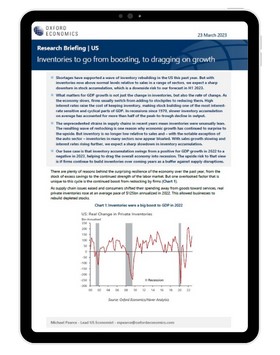Research Briefing
| Mar 23, 2023
US inventories to go from boosting, to dragging on growth

Shortages have supported a wave of inventory rebuilding in the US this past year. But with inventories now above normal levels relative to sales in a range of sectors, we expect a sharp downturn in stock accumulation, which is a downside risk to our forecast in H1 2023.
What you will learn:
- What matters for GDP growth is not just the change in inventories, but also the rate of change. As the economy slows, firms usually switch from adding to stockpiles to reducing them. High interest rates raise the cost of keeping inventory, making stock building one of the most interest-rate sensitive and cyclical parts of GDP. In recessions since 1970, slower inventory accumulation on average has accounted for more than half of the peak-to-trough decline in output.
- The unprecedented strains in supply chains in recent years mean inventories were unusually lean. The resulting wave of restocking is one reason why economic growth has continued to surprise to the upside. But inventory is no longer low relative to sales and – with the notable exception of the auto sector – inventories in many sectors now appear bloated. With sales growth slowing and interest rates rising further, we expect a sharp slowdown in inventory accumulation.
- Our base case is that inventory accumulation swings from a positive for GDP growth in 2022 to a negative in 2023, helping to drag the overall economy into recession. The upside risk to that view is if firms continue to build inventories over coming years as a buffer against supply disruptions.
Tags:
Related Services

Service
US Forecasting Service
Access to short- and long-term analysis, scenarios and forecasts for the US economy.
Find Out More
Service
US States and Metro Service
Forecasts, scenarios and analysis for US states, metropolitan statistical areas and counties.
Find Out More
